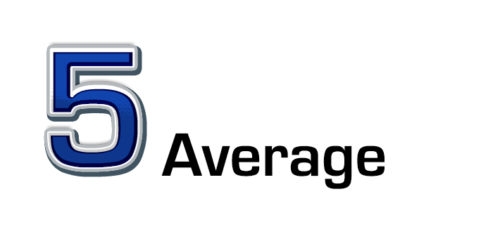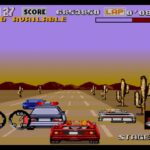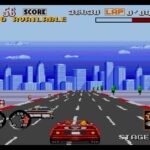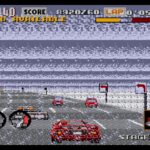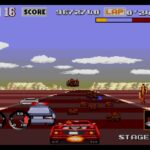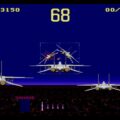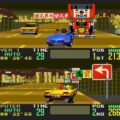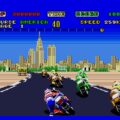Developer: Tiertex Publisher: Sega Released: 1992 Genre: Racing
Outrun was a formative racing game for me. I played the console version first and had my mind suitably blown when I saw the arcade game. But more than its technical prowess was its control and the way it captured the essence of driving. I loved it so a sequel should have been an easy slam dunk. Turbo Outrun is not a bad game but feels more like a half step rather than a full blown follow-up. The changes to the formula make it less compelling than its legendary predecessor.
The half step feeling of Turbo Outrun is because in the arcade it was an upgrade to the original Outrun. As such it does not seek to reinvent the wheel but offer more of what you liked originally. If the game were simply Outrun with a new set of stages it would have succeeded. Instead they took out the features that gave the first game so much replay value. And the graphical upgrade is completely lost on the Genesis, making this a lesser game in my eyes.
On the surface Turbo Outrun does have some subtle enhancements. You have a choice between manual and automatic transmission for one. While it was easy to adapt to gear shifting in the original the fact the game gives you a choice is awesome. The turbo in the title refers to the nitro boost you can initiate at the tap of a button. You can use turbo up until the meter overheats at which point there is a cool down. Proper management of turbo is key to victory as the checkpoints are less forgiving this time around. Lastly every fourth checkpoint you can select one upgrade among three that each offer tangible benefits. Eventually you will earn all of them but for each leg of the “race” certain parts are better like tighter handling. That is because this time the format of your journey is different.
The biggest change, and the one that hurts it the most, is its structure. Rather than one large map with a series of interconnected routes Turbo Outrun is straightforward sixteen course trip across the US. Beginning in New York you make your way cross country to Los Angeles with stops in iconic cities and states along the way. There is a great deal of visual variety, or at least there was, and while some of connections to each city are slight I can respect the attempt. While you aren’t competing for position you do have a rival who will steal your girl if you drive terribly. Aside from random cars the police will occasionally harass you if they catch up but all they do is slow you down, which in this game can be fatal.
It sounds like they have done a lot to make the overall experience more interesting. But in practice it is not. Losing the different routes completely kills any replay value the game might have had. Most racing games are one and done. In Outrun’s case the various routes and their different tracks offered many hours of entertainment. Here the game never changes and once you have mastered the tracks there is nothing to look forward to. I would argue the route system was Outrun’s best feature, even more so than its graphics and soundtrack. The tradeoff in this case was not worth it in my book.
One of the biggest reasons for Turbo Outrun’s existence was its visual upgrade. The cross country trip is spruced up with a variety of weather effects like snow, rain, and dust storms. Together with the always impressive Super-Scaler effect Turbo Outrun looked spectacular, at least in the arcade. You will find very little of that visual pizazz here unfortunately. In terms of track side detail this is a step back from its predecessor and looks worse. The attempts at simulating the weather are at best laughable and at their worst cause navigation issues. Even the music is a step back. I’m struggling to find anything good to say about this version on a technical level and I can’t which is sad considering the generally excellent done porting the first game.
In Closing
In the end Turbo Outrun is simply average. It is neither offensive nor exceptional. There is fun to be had but at the same time you could play a better racing game instead. The Outrun name can only carry it so far, leaving this a missed opportunity to really expand the formula.
